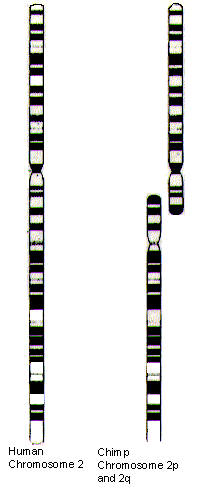
Human Chromosome 2 is a fusion of two ancestral chromosomes
Alec MacAndrew
Introduction
All great apes apart from man have 24 pairs of chromosomes. There is therefore a hypothesis that the common ancestor of all great apes had 24 pairs of chromosomes and that the fusion of two of the ancestor's chromosomes created chromosome 2 in humans. The evidence for this hypothesis is very strong.
The Evidence
Evidence for fusing of two
ancestral chromosomes to create human chromosome 2 and where there has been
no fusion in other Great Apes is:
1) The analogous chromosomes (2p and 2q)
in the non-human great
apes can be shown, when laid end to end, to create an identical banding
structure to the human chromosome 2. (1)
2) The remains of the sequence that the chromosome has on its ends (the telomere) is found in the middle of human chromosome 2 where the ancestral chromosomes fused. (2)
3) the detail of this region (pre-telomeric sequence, telomeric sequence, reversed telomeric sequence, pre-telomeric sequence) is exactly what we would expect from a fusion. (3)
4) this telomeric region is exactly where one would expect to find it if a fusion had occurred in the middle of human chromosome 2.
5) the centromere of human chromosome 2 lines up with the chimp chromosome 2p chromosomal centromere.
6) At the place where we would expect it on the
human chromosome we find the remnants of the chimp 2q centromere (4).
Not
only is this strong evidence for a fusion event, but it is also strong
evidence for common ancestry; in fact, it is hard to explain by any other
mechanism.

Explanations
Telomere evidence
The telomere is a sequence of DNA at the end of the chromosome. The function of the telomere is to protect the ends of the chromosomal DNA strands during replication. The ends of the strands are very vulnerable to mutations or deletions. Telomeres consist of, or contain long stretches of simple DNA sequences that are repeated many times. The telomeres tend to be shortened over time and are restored by an enzyme called telomerase which lengthens the sequence. If the telomere becomes too short in somatic cells, errors in duplication can occur leading to cancers.Centromere evidence
Turning now to the centromere. The process of somatic cell division (mitosis) is as follows (this is a very brief and simplified summary to explain the centromere):
|
1) The
genetic material is duplicated. At this stage, called interphase, the DNA
strands are extended and invisible. Although there are still 23 pairs of
chromosomes in humans, each one has twice the DNA material compared with a
non-dividing cell |
||||||
Let us re-iterate what we find on human chromosome
2. Its centromere is at the same place as the chimpanzee chromosome 2p as
determined by sequence similarity. Even more telling is the fact that on the
2q arm of the human chromosome 2 is the unmistakable remains of the
original chromosome centromere of the common ancestor of human and chimp 2q
chromosome, at the same position as the chimp 2q centromere (this
structure in humans no longer acts as a centromere for chromosome 2.
Conclusion
The evidence that human chromosome 2 is a fusion of two of the common
ancestor's chromosomes is overwhelming.
1. http://www.fhcrc.org/labs/trask/subtelomeres/
2. Yunis, J. J., Sawyer, J.R., Dunham, K., The striking resemblance of high-resolution g-banded chromosomes of man and chimpanzee. Science, Vol. 208, 6 June 1980, pp. 1145 - 1148
3. IJdo JW, Baldini A, Ward DC, Reeders ST, Wells RA, Origin of human chromosome 2: an ancestral telomere-telomere fusion. Proc Natl Acad Sci U S A 1991 Oct 15;88(20):9051-5; available on-line here:
http://www.pnas.org/cgi/reprint/88/20/9051.pdf
4. Avarello R, Pedicini A, Caiulo A, Zuffardi O, Fraccaro M, Evidence for an ancestral alphoid domain on the long arm of human chromosome 2. Hum Genet 1992 May;89(2):247-9